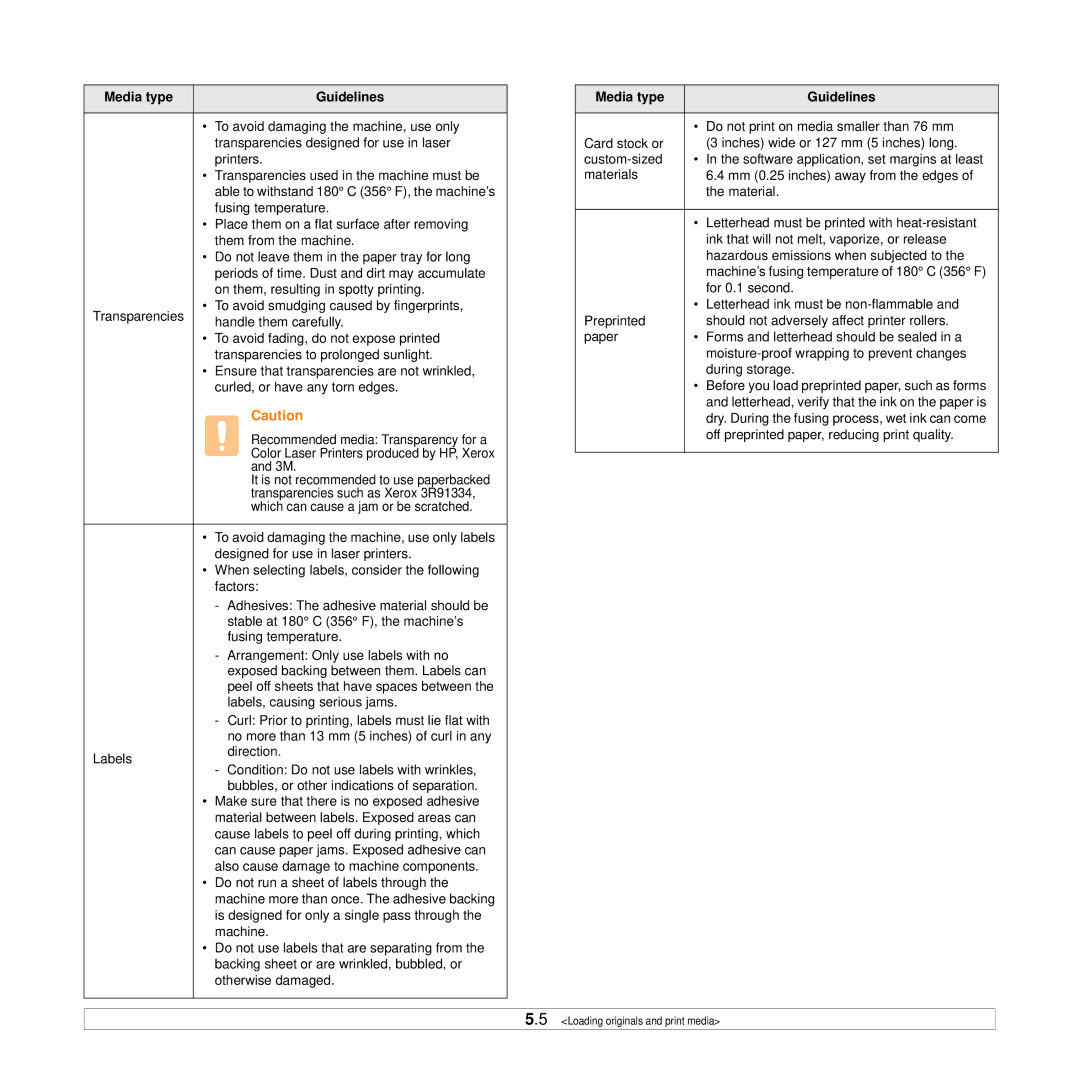
Media type |
|
| Guidelines |
|
|
| |
| • | To avoid damaging the machine, use only | |
|
| transparencies designed for use in laser | |
|
| printers. | |
| • | Transparencies used in the machine must be | |
|
| able to withstand 180° C (356° F), the machine’s | |
|
| fusing temperature. | |
| • | Place them on a flat surface after removing | |
|
| them from the machine. | |
| • | Do not leave them in the paper tray for long | |
|
| periods of time. Dust and dirt may accumulate | |
|
| on them, resulting in spotty printing. | |
Transparencies | • | To avoid smudging caused by fingerprints, | |
| handle them carefully. | ||
|
| ||
| • | To avoid fading, do not expose printed | |
|
| transparencies to prolonged sunlight. | |
| • | Ensure that transparencies are not wrinkled, | |
|
| curled, or have any torn edges. | |
|
|
| Caution |
|
|
| Recommended media: Transparency for a |
|
|
| Color Laser Printers produced by HP, Xerox |
|
|
| and 3M. |
|
|
| It is not recommended to use paperbacked |
|
|
| transparencies such as Xerox 3R91334, |
|
|
| which can cause a jam or be scratched. |
|
|
| |
| • | To avoid damaging the machine, use only labels | |
|
| designed for use in laser printers. | |
| • | When selecting labels, consider the following | |
|
| factors: | |
|
| - | Adhesives: The adhesive material should be |
|
|
| stable at 180° C (356° F), the machine’s |
|
|
| fusing temperature. |
|
| - | Arrangement: Only use labels with no |
|
|
| exposed backing between them. Labels can |
|
|
| peel off sheets that have spaces between the |
|
|
| labels, causing serious jams. |
|
| - | Curl: Prior to printing, labels must lie flat with |
|
|
| no more than 13 mm (5 inches) of curl in any |
Labels |
|
| direction. |
| - | Condition: Do not use labels with wrinkles, | |
|
| ||
|
|
| bubbles, or other indications of separation. |
| • | Make sure that there is no exposed adhesive | |
|
| material between labels. Exposed areas can | |
|
| cause labels to peel off during printing, which | |
|
| can cause paper jams. Exposed adhesive can | |
|
| also cause damage to machine components. | |
| • | Do not run a sheet of labels through the | |
|
| machine more than once. The adhesive backing | |
|
| is designed for only a single pass through the | |
|
| machine. | |
| • | Do not use labels that are separating from the | |
|
| backing sheet or are wrinkled, bubbled, or | |
|
| otherwise damaged. | |
|
|
|
|
Media type |
| Guidelines |
|
|
|
| • | Do not print on media smaller than 76 mm |
Card stock or |
| (3 inches) wide or 127 mm (5 inches) long. |
• | In the software application, set margins at least | |
materials |
| 6.4 mm (0.25 inches) away from the edges of |
|
| the material. |
|
|
|
| • | Letterhead must be printed with |
|
| ink that will not melt, vaporize, or release |
|
| hazardous emissions when subjected to the |
|
| machine’s fusing temperature of 180° C (356° F) |
|
| for 0.1 second. |
| • | Letterhead ink must be |
Preprinted |
| should not adversely affect printer rollers. |
paper | • | Forms and letterhead should be sealed in a |
|
| |
|
| during storage. |
| • Before you load preprinted paper, such as forms | |
|
| and letterhead, verify that the ink on the paper is |
|
| dry. During the fusing process, wet ink can come |
|
| off preprinted paper, reducing print quality. |
|
|
|
5.5 <Loading originals and print media>
